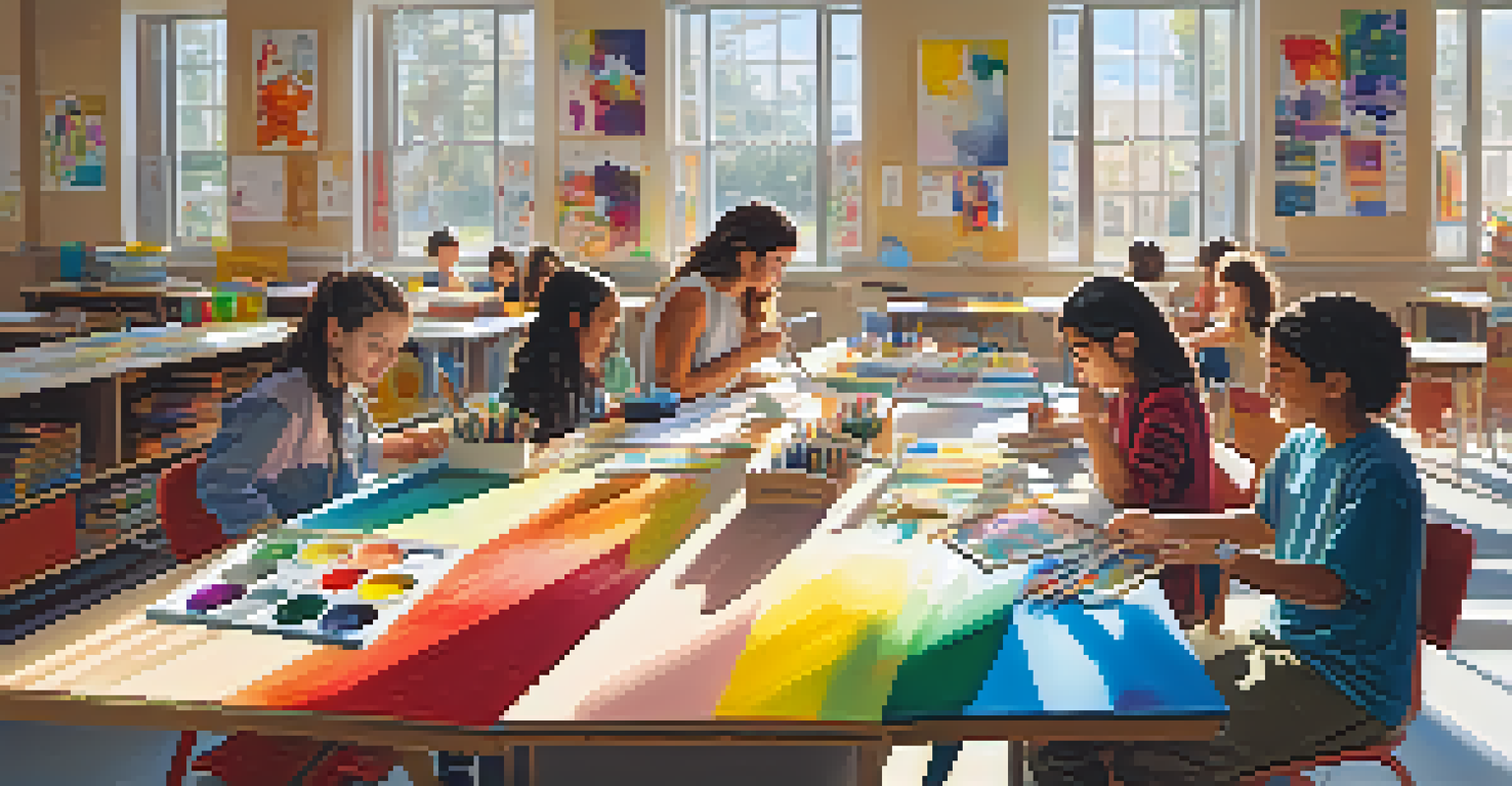Art Education as a Means of Promoting Social Equity

Art Education and Its Role in Social Equity
Art education serves as a vital tool for promoting social equity by providing diverse communities with opportunities for self-expression and creativity. It allows students from various backgrounds to explore their identities and share their unique perspectives. This inclusivity not only enriches the learning environment but also fosters a sense of belonging among students.
Art is the most beautiful of all lies; it is the most effective means of communicating the truth.
When art education is accessible to all, it breaks down barriers that often marginalize specific groups. By giving everyone a voice, we can challenge stereotypes and promote understanding across different cultures. This collective creativity can lead to greater social harmony as students learn to appreciate each other's differences.
Furthermore, art education encourages critical thinking and problem-solving skills, which are essential for navigating today's complex world. By engaging with various forms of art, students develop their ability to analyze situations and propose innovative solutions, equipping them to advocate for social change.
Bridging Gaps Through Community Art Programs
Community art programs play a crucial role in bridging gaps between various social groups. These initiatives often target underserved populations, providing resources and support to those who may not have access to traditional art education. By creating spaces where individuals can collaborate, these programs cultivate a strong sense of community.

For example, community murals can bring residents together, allowing them to express their stories and aspirations visually. This collaborative process not only beautifies neighborhoods but also fosters pride and ownership among community members. Such projects can serve as catalysts for larger conversations about social issues affecting the area.
Art Education Enhances Social Equity
Art education promotes inclusivity, allowing diverse voices to be heard and fostering understanding among different cultures.
Moreover, these programs often include workshops and classes that teach valuable skills, empowering participants to pursue careers in the arts. This not only enhances individual skill sets but also strengthens the community's creative economy, creating more equitable opportunities for all.
The Impact of Art on Mental Health and Well-being
Art education isn't just about creating beautiful works; it also significantly impacts mental health and well-being. Engaging in artistic activities can be a powerful form of therapy, allowing individuals to process emotions and cope with stress. This therapeutic aspect is especially important in marginalized communities where mental health resources may be limited.
Every artist was first an amateur.
By integrating art into educational settings, students can find healthy outlets for their feelings and experiences. This not only improves their mental health but also enhances their academic performance. When students feel supported and understood through art, they're more likely to engage positively in other areas of their education.
Additionally, art promotes resilience by encouraging individuals to express themselves creatively, even in challenging circumstances. This resilience is crucial for overcoming obstacles and achieving success, further contributing to social equity as individuals gain the confidence to pursue their goals.
Art as a Vehicle for Cultural Awareness
Art education fosters cultural awareness by introducing students to various artistic traditions from around the world. This exposure helps students appreciate the richness of different cultures and encourages them to celebrate diversity. As they learn about different artistic expressions, they also gain insights into the histories and experiences that shape those cultures.
Through projects that explore themes of identity and heritage, students can connect with their own backgrounds while also respecting those of their peers. This mutual understanding can break down prejudices and promote empathy, which are essential components of social equity. Students learn that art can serve as a bridge between different cultures.
Community Programs Empower Collaboration
Community art programs bridge social gaps by providing resources and creating spaces for collaboration among underserved populations.
Moreover, cultural exchanges within art education can inspire innovative collaborations, blending various artistic styles and ideas. These interactions create a dynamic learning environment that reflects a more inclusive society, preparing students to thrive in our increasingly globalized world.
Empowering Youth through Art Activism
Art activism empowers young people to become advocates for social change. By engaging with issues that matter to them, students can use their artistic talents to raise awareness and inspire action. This sense of agency is crucial for fostering a generation of socially conscious individuals committed to making a difference.
For instance, youth-led art projects can address topics such as climate change, social justice, or mental health. These projects not only amplify their voices but also connect them with like-minded peers and mentors. By collaborating on these initiatives, students learn the importance of teamwork and advocacy.
As they navigate the process of creating change through art, young people develop essential skills such as leadership, communication, and critical thinking. These skills not only benefit their personal growth but also contribute to the broader movement for social equity, as they become informed citizens dedicated to improving their communities.
The Role of Schools in Promoting Art Education
Schools play a pivotal role in integrating art education into their curricula, making it accessible to all students. By prioritizing arts education, schools can foster an environment where creativity flourishes and diverse voices are heard. This commitment to the arts is essential for cultivating well-rounded individuals prepared to contribute to society.
Incorporating art into various subjects helps students see the connections between disciplines, enhancing their overall learning experience. For example, a history lesson can come alive through a creative project, allowing students to engage with the material in a meaningful way. This interdisciplinary approach enriches their education and promotes critical thinking.
Art Activism Inspires Youth Engagement
Engaging in art activism empowers young people to advocate for social change and develop essential skills for leadership and community improvement.
Moreover, when schools collaborate with local artists and community organizations, they can provide students with real-world experiences and mentorship opportunities. These partnerships enhance the educational landscape and ensure that students have the tools and resources they need to thrive in the arts and beyond.
A Call to Action: Supporting Art Education Initiatives
To promote social equity through art education, it's essential for individuals and communities to come together and support relevant initiatives. This can involve volunteering time, donating resources, or advocating for policies that prioritize arts funding in schools. By actively participating in these efforts, we can help create a more equitable educational landscape.
Additionally, raising awareness about the importance of art education can inspire others to take action. Sharing stories of how art has positively impacted individuals and communities can motivate people to support local programs or even start their own initiatives. Conversations around art and social equity can spark interest and lead to collaborative efforts.

Ultimately, the responsibility for promoting art education lies with all of us. By working collectively to support these initiatives, we can empower future generations to use their creativity as a force for social change, paving the way for a more equitable and just society.